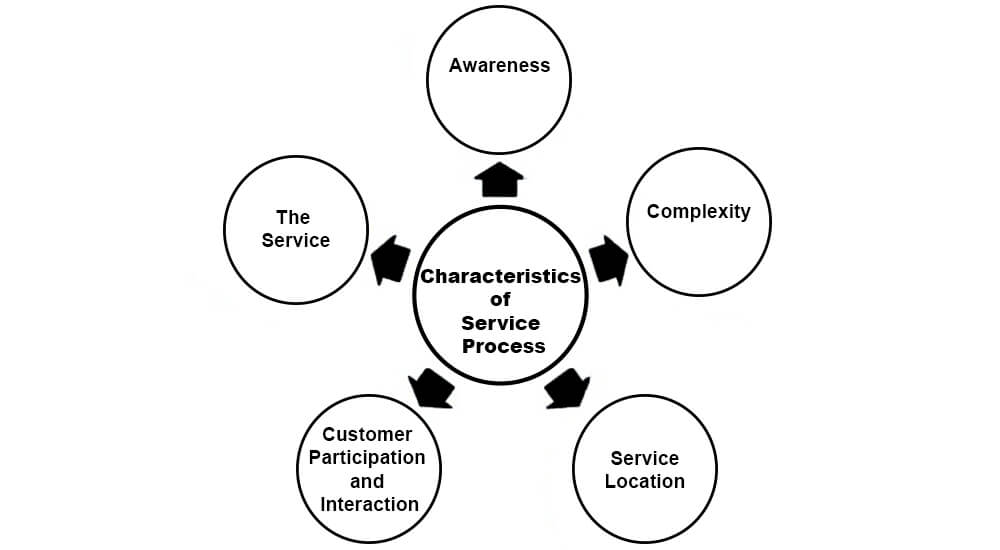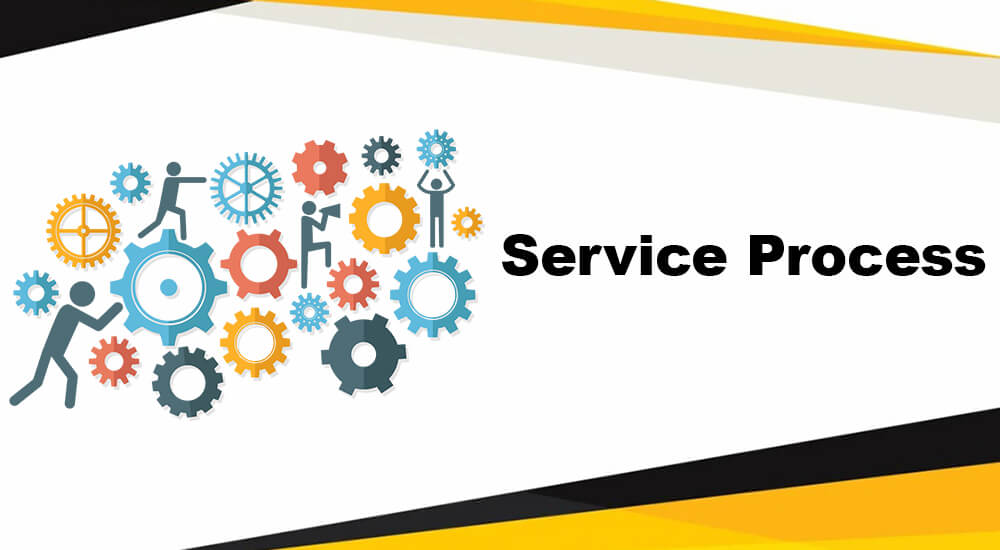The service process refers to the steps required to deliver a service. Service includes taking the order to deliver the product or following up with consumers regarding issues, resolutions, feedback, etc.
The goal of the service process is to ensure customers receive the same high-quality experience in all stages.
This blog post will discuss the successful service process, its main characteristics, and its elements.
What is the Service Process?
The service process is a series of activities performed to deliver a service to customers. The term is often used in manufacturing and logistics to describe how raw materials are transformed into finished products, but it is mostly used in customer-facing activities, such as providing professional services, delivering food orders, etc.
Every organization has a service process that reflects its mission, values, and competitive advantages.
The service process begins with identifying customer needs and ends with the customer’s satisfaction. It includes all the steps in between, such as planning, designing, producing, shipping, and delivering the finished product or service, and then after-sales support and feedback.
Characteristics of the Service Process

The service process is key to a business. It has five main characteristics:
- Divergence: When service providers deviate from standard service to meet different customer needs, it is called divergence. With divergence, customers can get the specific service they need, rather than generic.
- Complexity: Service processes with many steps or interactions can be complex. The process should be simple in order to provide the right expectations to customers.
- Service Location: Services can be provided in-person, online, or by phone. Consider the service location for easy access.
- Customer Participation and Interaction: Customers need to be involved in the process to receive the service. This interaction can happen in person, online, or over the phone.
- The Service: The service itself is an essential part of the process. Customers are paying for it, and it needs to be on par with their expectations.
A 7 Step Process for Managing Service Processes
The service process is the backbone of the business.
The basic framework for the service process is given below.
Step # 1. Flowcharting
Flowcharting refers to creating a diagram that shows the steps in a process and their relation. The flowchart outlines all steps involved in the process.
Businesses can gain valuable insights by looking at the process from a high-level perspective and seeing how all steps fit together. It shows where improvements can be made and help train new employees.
Step # 2. Service Blueprinting
After creating a flowchart, a service blueprint is developed. The service blueprint shows how the customer interacts with the service process. It includes steps in the process and shows what happens at each step.
The service blueprint can help identify potential problems and areas where improvements can be made. It will also help organizations understand how the customer interacts with the process and their experience.
Step # 3. Identify Failure Points
The next step is to identify failure points in the process. A failure point is a place where issues can occur. Failure can be caused by human error, equipment failure, etc.
As the U.S. Small Business Administration states, addressing these bottlenecks can bolster service efficiency.
Identifying failure points is key to improving the service process. It also helps in creating contingency plans for when things go wrong.
Examples of failure can be a lack of:
- Staff to handle customer demands
- The right tools to finish the job
- A clear understanding of the process
Step # 4. Failure Proofing
After identifying the failure points in the process, the next step is to failure proof them. Failure proofing making changes to the process to stop failures from happening.
There are different ways to failure proof a service process.
Some common methods include:
- Adding additional staff to handle customer demands
- Providing more training to employees
- Installing better equipment or tools
- Creating clearer instructions for the process
Step # 5. Setting Service Targets
The next step is to set service targets. Service targets are goals that businesses want to achieve. They can be customer satisfaction, quality, speed of service, etc.
Setting service targets is important because it helps track progress and ensure that goals are being met. It also helps to identify areas where modifications are required.
Step # 6. Service Process Redesign
Once service targets have been set, the next step is to redesign the process to meet those targets. Here, processes are redesigned to improve quality, speed of service, customer satisfaction, etc.
This step can change:
- The way tasks are performed
- The order of tasks
- The tools and equipment used
- The training provided to employees
- The customer interface
Step # 7. Managing Customers Effectively
When it comes to providing service, managing customers is the key. Customers can be valuable assets or liabilities. It is important to know how to manage them effectively, so they become an asset.
There are many ways to manage customers effectively.
Below are steps to follow.
- Recruitment and Selection: Recruit people with the right skills and attitude for the job.
- Job Analysis: Understand the job and customers’ requirements.
- On-boarding: Train customers on how to use the service.
- Coaching and Feedback: Provide coaching and feedback to help customers improve their performance. Give them opportunities to develop their skills further.
- Motivate the Best Performer: Recognize and reward good performance. Help them see how their efforts contribute to the company’s success.
- Appraisal: Review customer performance regularly. Take action to improve their performance if necessary.
Elements of the Service Process
The three basic elements of the service process are the people involved, the processes used, and the physical evidence they produce. The interaction between these three elements creates the customer experience.
- People: The people in a service process play an essential role in creating a positive customer experience. They need to be friendly and helpful, knowledgeable, and skilled to provide the service.
- Processes: The processes must be efficient, effective, and designed with the customer in mind.
- Physical Evidence: Physical evidence is anything that the customer can see, touch or hear that provides them with information about the service. It can include staff appearance, display notes, service environment, etc.
Decisions Required for Planning a Service Process
The following decisions are important for a service provider in planning its service process.
- The Layout Design: The layout of the service facility plays an important role in the efficiency and effectiveness of the service process. The layout should be designed to meet the needs of customers and employees.
- Equipment: The service should use the right equipment to serve the consumers.
- The Organizational Structure: The service provider’s organizational structure should be designed to meet the needs of the service process.
- Technology: The service process should use the right technology to serve the consumers.
- Training and Development Needs: Employees’ training and development needs should be assessed and addressed in the service process.
- The Customer Service Policies: The customer service policies should be designed to meet the needs of the customers and the employees.
Elements of Blueprinting
A well-designed service process can make the difference between a satisfied and unsatisfied customer. There are several elements to consider when blueprinting the service process.
- Service Location: The location is the first element where the service will be delivered. This could be a storefront, office, or other physical space. It’s important to consider the customer’s proximity and how easily they can access the service location.
- Service Personnel: This includes the employees who interact with customers and support staff who may not be directly involved in customer interactions. Consider the skills and training required for each role and how they will work together to deliver the service.
- The Flow of Process: This includes how customers interact with employees and steps taken to receive the service. Consider the customer’s point of view when designing the flow and ensure it is easy to understand and follow.
- Service Tools/Equipment: This includes everything from office supplies to specialized equipment or software. These tools should be easy to use, well maintained, and require little maintenance.
- Conversion Process: This is how customers will be converted into paying clients. Pay attention to the sales process and steps required to close a sale.
- Technology: This includes everything from the software used to deliver the service to the devices customers use to access it. Ensure that technology is easy for employees to use and meets customer expectations.
- Support Processes: This includes everything from accounting to human resources. These processes should be efficient and support service delivery.
- Customer Role: This includes everything from how customers will be involved in the service process to their expectations. Include feedback while designing the process so they feel like they are part of it.
- Employee Actions: This includes specific tasks employees need to do in order to interact with customers. Employees must have the information and training they need to deliver the service.
Challenges in Designing the Service Process
There are four major challenges in designing the service process in any organization that provides a service.
- Oversimplification: Making the process too simple can lead to inconsistency and errors.
- Subjectivity: Service processes are often highly subjective, and what works for one customer may not work for another.
- Incompleteness: The process accounts for all possible customer interactions, not just the most common ones.
- Biased Interpretation: The people who design the service process may have a biased interpretation of what the customer wants or needs.
Conclusion
The service process describes all activities that go into providing a service. It begins with customer interest in the product or service and ends with their satisfaction.
The service process is often intangible, but it is the backbone to delivering a great customer experience. Understanding and applying its principles can create an exceptional customer experience that sets a business apart from the competition.
